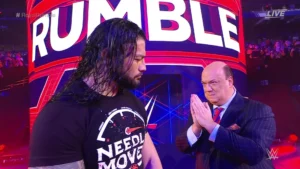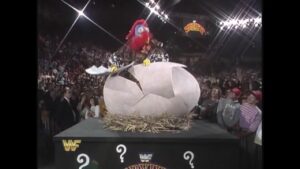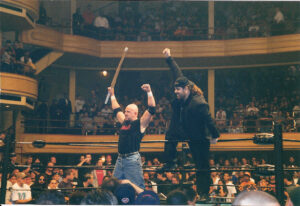Every pro-wrestling fan knows of Dustin Rhodes as Goldust. The Bizarre One – as he is commonly known – has been a key component of the World Wrestling Entertainment (WWE) roster for over twenty years. Whereas he wasn’t as popular nor as successful as the mega stars of the Attitude Era (Steve Austin, The Rock, The Undertaker etc), he is often credited as being one of the founders of it – and rightfully so.
https://youtu.be/OS2XK_pSLj8
Goldust’s strange, un-PC, downright polarising persona of the mid-to-late 1990s was ahead of its time. His contribution to the Attitude Era – as well as his years of solid in-ring work, promos and entertaining segments (the stuff with Booker T still stand as some of the most memorable WWE segments ever) make Goldust a certified future WWE Hall of Famer. When younger brother, Cody, threatens to “kill” the Attitude Era once and for all by ending his brother’s career at All Elite Wrestling‘s Double or Nothing event, he means it.
So, with all being said about Goldust, what about Dustin Rhodes?
Dustin Rhodes is the anti-Goldust. More serious, Dustin relies more heavily on his size (it is sometimes easy to forget that Dustin is a big man, standing over 6 and a half feet tall) and more closely resembles the “Common Man” that was his father, “The American Dream”, Dusty Rhodes. His hair just as golden, his face just as scarred, you can tell that this man is the son of the “American Dream”. “The Natural” Dustin Rhodes, as he was named in his second, more successful stint in World Championship Wrestling, looks every bit of a wrestler as anyone else to have stepped through a set of ropes. There is no golden facepaint; no comical stutter or ball-gags, there is only a man with two fists and the presence of a pro-wrestler.
Dustin Rhodes began his illustrious career in Championship Wrestling from Florida, debuting for the promotion in September of 1988. Just three months later, he would debut for World Championship Wrestling, as one half of the Texas Broncos with tag team partner, Kendall Windham. This WCW run would end just two months later, however, as he would leave the company with his father, Dusty Rhodes.
Dustin would then go overseas, wrestling for All Japan Pro Wrestling, under the name “Dusty Rhodes Jr.”, competing in the annual Champion Carnival Tournament. This would also prove to be a shortened stint, however, as Dustin – in late 1990 – would debut in the promotion where he would eventually make his name: the World Wrestling Federation.
Dustin would debut for the WWF on the 21st of September, 1990, against Paul Diamond. Wrestling as a babyface, Dustin would soon join forces with his father, feuding with the team of Ted DiBiase and Virgil. The feud would culminate at Royal Rumble 1991 and following a losing effort against Virgil and DiBiase, Dusty and Dustin would, once more, leave together. So whereas Dustin’s most memorable run in wrestling came in the WWF/WWE, it is worth remembering that his initial stint in the McMahon-ran company was one almost as short-lived as his initial WCW run.
Dustin would return to WCW, where he would remain from 1991-1995, the longest run within a company of his career so far. It is worth noting that this is the run in which he became known as “The Natural” Dustin Rhodes – a title not so dissimilar to Charlotte Flair’s “Genetically Superior”. Additionally, this run would prove to be Dustin’s most successful so far as – on January 11th, 1993 – Dustin would capture his first WCW United States Championship (the first of two) after it was vacated, following an injury to then-current champion, Rick Rude.
He defeated Ricky Steamboat for the vacant championship. Upon Rude’s return, the title would be vacated again – with it being decided Dustin would face Rude in a series of matches (best-of-three) to see who the true champion really was. Dustin would win this series – arguably the biggest win of his career so far – and would hold it for a couple more months, before losing it to a young, pre-Texas Rattlesnake Steve Austin. Following an incident in which Dustin bladed during a match (against the rules at the time), Dustin and his competitor, The Blacktop Bully, were both fired from WCW.
https://youtu.be/K655jz-vB_g
Dustin returned for his second stint in the WWF – a stint notable for the beginning of the Goldust character. In a series of pre-debut vignettes, Goldust – wearing the beginnings of his iconic facepaint (at the time just a gold-painted face and black lipstick), a golden suit and his iconic golden wig – would cut bizarre promos from the hills of Los Angeles, California.
In the present day, Goldust’s early act wouldn’t be too outrageous, thanks in large part to Ru Paul’s Drag Race, but at the time, this was a considerably controversial gimmick – especially in the WWF which, until this point, had not strayed too far into the unknown. This is why Cody considers Goldust as being so representative of the Attitude Era: he is absolutely one of the forefathers of the shift to edgier wrestling in the mid-1990s.
At the time, Vince McMahon was largely behind the gimmicks of his wrestlers; usually choosing cartoony characters who he felt the young TV audience could love or hate with ease. According to Dustin, he accepted the Goldust character after Vince McMahon conversed with him over the likelihood of Dustin being able to play such an androgynous character. Dustin admits to having accepted the character without knowing what the word “androgynous” actually meant and upon learning of the definition, questioned “what have I done?”
Thankfully, he did accept, because the Goldust character is one of the most recognisable, enjoyable and beloved in wrestling history – certainly in recent memory – and is a staple of the late 90s era of pro-wrestling, which remains arguably the most popular of all time. The initial run of Goldust bore championship gold, too, as he captured the Intercontinental Championship from Razor Ramon at Royal Rumble 1996 – five years after leaving the WWF. This was also when his then-wife, Terri Runnels, under the name Marlena, began working as his valet.
https://youtu.be/G2D2lJbC6TU
Dustin would have a couple more years in the WWF as Goldust, before eventually leaving for one final stint in WCW – where he would work as Seven, a character more closely resembling “The Bizarre One” Goldust than “The Natural” Dustin Rhodes, who the WCW audience had previously seen him work as. The character was soon dubbed too controversial for Ted Turner, however, and Dustin soon began working as “The American Nightmare” Dustin Rhodes. Sound familiar? Cody wasn’t the first American Nightmare, I can assure you. This version of Dustin was the anti-Dusty – evil Dusty, in basic terms. He would then wrestle in WCW right until the very end – even working WCW Greed (the final PPV) on March 18th, 2001.
https://youtu.be/sfc0XuP2GEE
After the end of WCW, Dustin would, of course, return to the WWE. This stint would become arguably the most memorable of his career, as it was during this time the famous Booker T and Goldust team was born. It would be fair to say that this was a sort of demotion for both men, as they were relegated to comedy sketches; making numerous hilarious backstage segments. However, the bromance of the two characters (something which stands today) and their natural ability to make audiences laugh in such outlandish segments as “Darth Goldust” has made the team as memorable as any other. The chemistry shared by Booker T and Goldust, too, is as potent as any other.
Following another exit from the company in 2003, Dustin would make numerous appearances across wrestling, where he would feature in a number of backstage segments in WWE (as a guest), in short stints in companies such as Total Nonstop Action Wrestling (now Impact Wrestling), AJPW (a long-awaited return) and others. It was during this time where Dustin was at his lowest, however, and therefore we will skip ahead a few years to probably the most important part of this article: his team with Cody Rhodes and, later, Stardust.
The team of Cody Rhodes and Goldust was one which was hugely popular; go back and watch their feud with The Shield – culminating in the Shield’s first ever loss. The crowd were so into Cody and Goldust that they could no longer be ignored and, over twenty years into Dustin’s distinguished career, he achieved something he always wanted: to team with his younger brother in front of their father. Over twenty years into his career, this was arguably the most popular Goldust had ever been, displaying the longevity of the Attitude Era crafted Goldust character. Which brings us back to the original point: Dustin vs Cody.
Cody loves his brother, but wants to kill the Attitude Era. Dustin loves his brother, but will defend the Attitude Era always – for without the Attitude Era, there would be no Goldust and without Goldust, there might have been no Attitude Era. This is why the stakes are so high going into this match. Rhodes vs Rhodes is far from a generic family feud; it is the war between two generations.
Everything that the Attitude Era stands for – over-the-top entertainment, grittiness, outlandish humor and more – are personified in the Goldust character. Cody represents the present generation that came after the Attitude Era; the generation who are forever judged on what came before them. This is Cody’s chance to, once and for all, put the Attitude Era to sleep. The botched WWE feud between the two brothers in 2015 bore just one match; resulting in a Goldust win at WWE Fastlane. For Dustin, it is now Double or Nothing.
Check out our other #AllEliteWeek articles for more AEW news heading into Double or Nothing this Saturday!
- Quick Guide to Everything Elite (5/20/19)
- All Inclusive: Nyla Rose Becomes First Transgender Wrestler Signed to Major Contract (2/8/19)
- Joshi Freelancer Hikaru Shida Joins AEW (4/9/19)
- Match Point: Aja Kong, Emi Sakura & Yuka Sakazaki vs. Riho, Hikaru Shida & Ryu Mizunami (5/13/2019)
- The Zebras Are Coming: AEW Announces Ref Signings (5/14/19)
- It’s Official: AEW Signs TV Deal with TNT/WarnerMedia (5/15/19)
- Casino Battle Royale & The Buy-In (5/20/19)
- AEW Debuts First Match: PAC vs Hangman Page (5/21/19)
- Shawn Spears (Tye Dillinger) Enters Casino Battle Royale (5/21/19)
- Best Friends Hit The Jackpot (5/21/19)
- The Young Bucks and the Road to AEW (5/22/19)
- Dustin Rhodes: A Golden Opportunity (5/22/19)
- AEW World Championship Plan Announced (5/22/19)
- Cody Rhodes Has Changed The Business in Three Years (5/23/19)
- Stong Hearts Invade Las Vegas (5/23/19)






